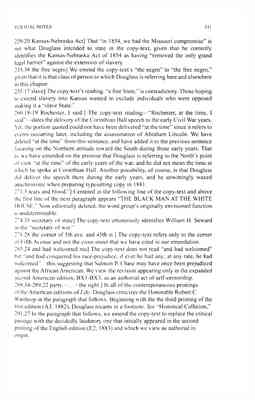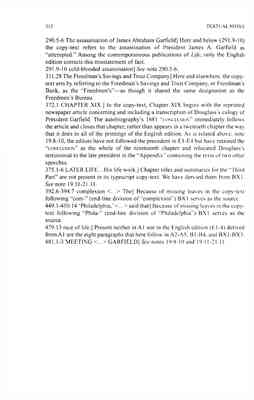Pages
1
Textual Notes
The decisions recorded in the "List of Emendations" typically reflect simple adherence to the editorial principles enunciated in the "Textual Afterword." Some emendations, however, merit more detailed explanation, and these notes explain complex situations encountered in the copy-texts and the interpretations of the author's probable intentions that have resulted in the emendation rationales applied. The page and line references at the beginning of each entry indicate the reading's location in the Yale edition. The symbols for the 1881-1895 editions and printings to which the entries refer are the same seen in this volume's "Descriptive Bibliography": A1-A5 signify the five printings of the first American edition; E1-E4 the English edition's four printings; B1-B4 the four second American edition's printings; BX1-BX3 the three printings of the expanded second American edition.
13.7-10 When deriving this chapter from My Bondage and My Freedom, Douglass excluded discussion of the differences in how rural and urban slaves are treated, as well as exceptions to the rule. The editors have emended the summary to describe how the copy-text actually reads.
18.11 Enfranchisement discussed—its accomplishment] We have emended the copytext's "Enfranchisement debated and accomplished" to the phrasing that appears in the otherwise identical description of the chapter contents at the head of Chapter XIII the "Second Part" of Life. Assumed is recognition after the initial description of the chapter of an obvious difference between Douglass having "debated" or only "discussed" enfranchisement: and, in light of how the conversation recorded in Chapter XIII reads, the latter verb is the appropriate one.
19.8-10 XIX ... convictions.] The title and summary of Chapter XIX initially appeared in A2 rather than A1. The summary included "Meeting of colored citizens in Washington to express their sympathy at the great national bereavement, the death of President Garfield"—referring to Douglass's eulogy of Garfield in this chapter of the copy-text. As we explain in the "Textual Introduction" and again address below in note 372.1, we view this late addition to the typesetting copy that Douglass provided as placed where it was in the autobiography by editor Sylvester Betts; and we have concluded that it is more properly situated as a third addendum to Life in its "Appendix." The emended chapter summary now reflects that, as does table of contents summary for the "Appendix." 21.14-17.
19.11-21.11 Table of Contents for the "Third Part"] Not present in the typescript copy-text for this section of Life are the chapter titles and content summaries added
509
2
510
TEXTUAL NOTES
in the first printing of the expanded second American edition. BX 1, that is, is the source for the emendations resulting in the table of contents entries and the same at the heads of the "Third Part" chapters. Affecting the emendations in the first three chapters are the differences between where the second and third begin in the copy-text and in BX1-BX3. Chapters I and II in the copy-text appeared as chapter I in BX1-BX3 ; and the copy-text's chapter III comprises II and III in BX1-BX3. We therefore emend the chapter content summaries in BX1-BX3 so that their descriptions correspond to the contents of the chapters in the copy-text.
23 . 1 FIRST PART.] Never corrected during Douglass's lifetime was the title of the first part—"LIFE AS A SLAVE."—which derived from the same section title of the 1855 version of the autobiography, Mv Bondage and My Freedom. We judge this development unintended, in light of the fact that the 1855 title of the second part. "LIFE AS A FREE MAN," did not reappear in 1881 but was replaced by "SECOND PART." Further, a decade later, Douglass might have elected to restore the discursive titles as he expanded Life, but he did not in BX I: the title of the newly added section in BX1 is "THIRD PART." See 15.34 and 147.12 in the "List of Emendations" for like emendations made upon the same basis.
42.36 Such floggings were] The copy-text reading in the present tense here ( "are" rather than "were") and in the next sentence ("prefer" rather than "preferred") arc representative of multiple subsequent readings in My Bondage and My Freedom that reappeard in Life with no acknowledgment of changed conditions in the post-Civil War period. See also 74.17 and 138.16-25 in the "List of Emendations" and notes 177.5 and 177.22 below.
60.13-15 See note 13.7-10.
147.12 life as a slave] As with the original title of the "First Part" of Life (see note 23.1), so with the copy-text's reference to "Life as a Slave" in this chapter summary and earlier at 15.34. We have emended the upper case letters to lower and deleted the quotation marks to reflect the fact that "Life as a Slave" no longer serves as the title of the autobiography's "First Part".
177.5 men taught] Typical of readings in My Bondage and My Freedom that were not revised in 1881 for publication in Life is the copy-text's "other able men have since taught their noblest lessons" in opposition to slavery. The reference is to what transpired since 1843— as of 1855. The reading was finally emended in 1892 to "men taught" during the preparation of the expanded second American edition. BX1. See also notes 42.36, 177.22, and 177.23.
177.22 See note 177.5 and 177 .23 for the same emendation rationale.
177.23 See note 177.22.
179.29 the head.] The copy-text refers to Mr. White being hit and then to William A. White receiving a blow, as though Douglass were specifying two individuals. In fact, the same man was struck both on the mouth and then on the back of his head. We have emended the sentence for the sake of clarity. deleting the second reference to White for that purpose.
3
TEXTUAL NOTES 511
229.20 Kansas-Nebraska Act] That "in 1854, we had the Missouri compromise" is not what Douglass intended to state in the copy-text, given that he correctly identifies the Kansas-Nebraska Act of 1854 as having "removed the only grand legal barrier" against the extension of slavery.
233.38 the free negro] We emend the copy-text's "the negro" to "the free negro," gi,en that it is that class of person to which Douglass is referring here and elsewhere in this chapter.
235.17 slave] The copy-text's reading. "a free State," is contradictory. Those hoping to extend slavery into Kansas wanted to exclude individuals who were opposed making it a "slave State."
260.18-19 Rochester, I said:) The copy-text reading—"Rochester, at the time, I said"—dates the delivery of the Corinthian Hall speech to the early Civil War years. Yet, the portion quoted could not have been delivered "at the time" since it refers to events occurring later, including the assassination of Abraham Lincoln. We have deleted "at the time" from this sentence, and have added it to the previous sentence focusing on the Northern attitude toward the South during those early years. That is, we have emended on the premise that Douglass is referring to the North's point of view "at the time" of the early years of the war, and he did not mean the time at which he spoke at Corinthian Hall. Another possibility, of course, is that Douglass did deliver the speech there during the early years, and he unwittingly waxed anachronistic when preparing typesetting copy in 1881.
271.5 tears and blood."] Centered in the following line of the copy-text and above the first line of the next paragraph appears "THE BLACK MAN AT THE WHITE HOUSE." Now editorially deleted, the word group's originally envisioned function is undeterminable.
274.35 secretary of state] The copy-text erroneously identifies William H. Seward as the "secretary of war."
278.28 the corner of 5th ave, and 45th st.] The copy-text refers only to the corner of Fifth Avenue and not the cross street that we have cited in our emendation. 283.24 and had welcomed me] The copy-text does not read "and had welcomed" but "and had conquered his race-prejudice, if ever he had any; at any rate, he had welcomed" this suggesting that Salmon P. Chase may have once been prejudiced agamst the African American. We view the revision appearing only in the expanded second American edition, BX1-BX3, as an authorial act of self-censorship.
288.34-289.22 party, ... the right.] In all of the contemporaneous printings of the American editions of Life, Douglass criticizes the Honorable Robert C. Winthrop in the paragraph that follows. Beginning with the the third printing of the first edition (A3, 1882), Douglass recants in a footnote. See "Historical Collation," 291.27 In the paragraph that follows, we emend the copy-text to replace the critical passage with the decidedly laudatory one that initially appeared in the second printing or the English edition (E2, 1883) and which we view as authorial in origin.
4
512 TEXTUAL NOTES
290.5-6 The assassination of James Abraham Garfield] Here and below (291.9-10) the copy-text refers to the assassination of President James A. Garfield as "attempted." Among the contemporaneous publications of Life, only the English edition corrects this misstatement of fact.
291. 9-10 cold-blooded assassination] See note 290.5-6.
311.28 The Freedman's Savings and Trust Company] Here and elsewhere, the copytext errs by referring to the Freedman's Savings and Trust Company, or Freedman 's Bank, as the "Freedmen's"—as though it shared the same designation as the Freedmen's Bureau.
372.1 CHAPTER XIX.] In the copy-text, Chapter XIX begins with the reprinted newspaper article concerning and including a transcription of Douglass 's eulogy of President Garfield. The autobiography's 1881 "CONCLUSION" immediately follows the article and closes that chapter, rather than appears in a twentieth chapter the way that it does in all of the printings of the English edition. As is related above, note 19.8-10, the editors have not followed the precedent in E1-E-4 but have retained the "CONCLUSION" as the whole of the nineteenth chapter and relocated Douglass 's testimonial to the late president in the "Appendix" containing the texts of two other speeches.
375.1-6 LATER LIFE ... His life work.] Chapter titles and summaries for the "Third Part" are not present in its typescript copy-text. We have denied them from BX1.
See note 19.11-21.11.
392.6-394.7 complexion ... The] Because of missing leaVes in the copy-text following "com-" (end-line division of "complexion") BX1 serves as the source.
449.1-450.14 'Philadelphia,· ... said that] Because of missing leaves in the copytext following "Phila-" (end-line division of "Philadelphia") BX1 serves as the source.
479.13 race of life.] Present neither in A1 nor in the English edition (E1-4) derived from A1 are the eight paragraphs that here follow in A2-A5, B 1-B-4, and BX1-BX3.
481.1-3 MEETING ... GARFIELD] See notes 19.8-10 and 19.11-21.11.



